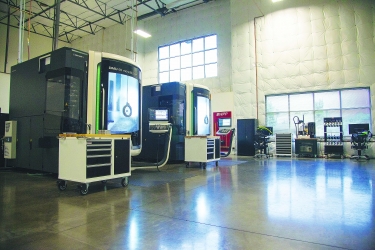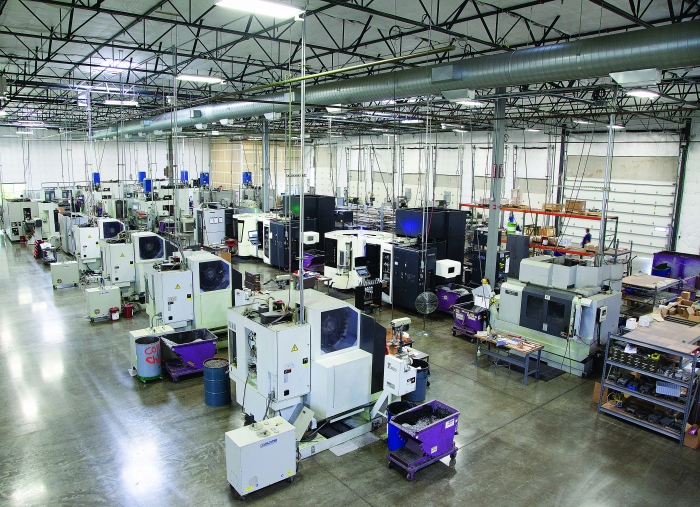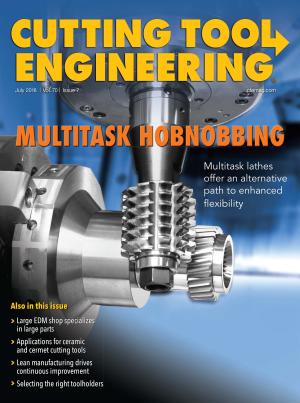Jerry Mullins knows that dozens of Portland, Ore.-area machine shops can make good parts, some with CNC equipment as capable as his own. That’s why his business philosophy, as well as his brother Bill’s, is to differentiate their company by providing high-quality service and a customer experience to match.
There’s an impressive equipment list behind that commitment and a history dating to the mid-1980s when company founder Larry Shodin bought a small turning shop and renamed it Western Precision Products Inc. He soon joined forces with Howard Mullins, owner of a nearby milling shop. They merged their turning and milling competencies. Then in 1995, Shodin sold his share to Howard and retired.

The “quick-turn” department at Western Precision Products boasts offline presetting, hyperMILL CAM software and a pair of DMU 65 monoBLOCK 5-axis machining centers from DMG Mori. Image courtesy of Western Precision Products
Today, Howard’s sons, Jerry and Bill, own the company. Located in Tualatin, Ore., the shop produces precision components for the aerospace, electronics, power supply and other industries. A building purchased in 2013 boasts 48,000 sq. ft. where about 80 people work. The company also owns and operates two small captive shops located at customer facilities.
Jerry said WPP has always tried to stay ahead of its peers. In 2006, the Mullins boldly invested in a three-machine, 36-pallet NH4000 DCG horizontal machining cell from DMG Mori.
Since then, the Mullins have invested further in DMG equipment, including another NH4000 DCG horizontal machining center (with a six-pallet pool), two five-pallet NHX4000 HMCs, some stand-alone NHX4000 and NHX5000 machines, several DuraVertical vertical machining centers, an NTX 2000SZM integrated mill-turn center and Swiss-style lathes from Citizen and Tsugami.
Some other examples of WPP’s embrace of advanced machining technology include 1,000-psi coolant systems on most machines. Spindle probes are the norm, as well as 4-axis capability, where applicable; large tool magazines; and spindle speeds up to 20,000 rpm.
In October, the Mullins took a step toward Industry 4.0, opening a prototype department with “state-of-the-art technology from top to bottom,” Jerry said. The shop installed a pair of DMU 65 monoBLOCK 5-axis machining centers from DMG Mori, invested in an offline tool presetting system equipped with Balluff-style Bluetooth chip readers and implemented a hyperMILL CAM system from Open Mind Technologies.

A bird’s-eye view of Western Precision Products’ state-of-the-art production floor.
Image courtesy of Western Precision Products
“It might be unfair to call it a prototype shop,” Jerry said. “Our emphasis is on rapid turnaround rather than any specific part quantity. If a customer wants to order 20 of something and needs it quickly, that’s fine—assuming it fits within our machine envelope and capabilities.”
That move has borne fruit, reducing part lead time and in-process inventory levels. The DMU machines also bring tremendous flexibility to the table. The company uses the equipment for 3+2 work, as well as 5-axis simultaneous machining. As a result, WPP has received new orders.
“Once our customers found out we have 5-axis capabilities, they sent full 5-axis work our way,” Jerry said. “We’ve also gained several new customers because of the DMUs.”
The shop’s first experience with offline presetting won’t be the last. Because the DMUs are equipped with Bluetooth chip readers, integration with WPP’s Haimer presetter is seamless. Information, including tool length, diameter, usage and wear, is quickly written to and read from the chip.
“The implementation right now is only two machines in a pretty small department, but the goal overall is error proofing and first-part accuracy,” Jerry said. “We’ve experienced both, especially the latter, largely because we can very accurately measure each tool before it goes into the machine.”
Simulation has also helped. Jerry said hyperMILL’s machine simulation is a must-have for 5-axis machining.
Simulation has not been the only software change. WPP recently implemented data collection through its JobBOSS enterprise resource planning system, allowing the company to improve scheduling capabilities while increasing visibility of the movement of jobs through the shop.
As Jerry can attest, finding qualified employees is a problem that technological advancements have made more difficult. He works with area schools, inviting high school students for tours and reaching out to the local college to show students the benefits of a manufacturing career.
“It used to be that you could stick pretty much anyone in front of a machine and tell them to push the green button,” Jerry explained. “That’s no longer where our industry is headed. We’re working with basically information systems now. You need people who can make parts, but they must be technologically minded and have a good grasp of computers and software. That’s why we show young people that modern manufacturing is not the dirty job they think it is. You can make a good living doing it.”
For more information about Western Precision Products Inc., call (503) 786-8923 or visit www.westernprec.com.
Related Glossary Terms
- centers
centers
Cone-shaped pins that support a workpiece by one or two ends during machining. The centers fit into holes drilled in the workpiece ends. Centers that turn with the workpiece are called “live” centers; those that do not are called “dead” centers.
- computer numerical control ( CNC)
computer numerical control ( CNC)
Microprocessor-based controller dedicated to a machine tool that permits the creation or modification of parts. Programmed numerical control activates the machine’s servos and spindle drives and controls the various machining operations. See DNC, direct numerical control; NC, numerical control.
- computer-aided manufacturing ( CAM)
computer-aided manufacturing ( CAM)
Use of computers to control machining and manufacturing processes.
- coolant
coolant
Fluid that reduces temperature buildup at the tool/workpiece interface during machining. Normally takes the form of a liquid such as soluble or chemical mixtures (semisynthetic, synthetic) but can be pressurized air or other gas. Because of water’s ability to absorb great quantities of heat, it is widely used as a coolant and vehicle for various cutting compounds, with the water-to-compound ratio varying with the machining task. See cutting fluid; semisynthetic cutting fluid; soluble-oil cutting fluid; synthetic cutting fluid.
- gang cutting ( milling)
gang cutting ( milling)
Machining with several cutters mounted on a single arbor, generally for simultaneous cutting.
- machining center
machining center
CNC machine tool capable of drilling, reaming, tapping, milling and boring. Normally comes with an automatic toolchanger. See automatic toolchanger.
- milling
milling
Machining operation in which metal or other material is removed by applying power to a rotating cutter. In vertical milling, the cutting tool is mounted vertically on the spindle. In horizontal milling, the cutting tool is mounted horizontally, either directly on the spindle or on an arbor. Horizontal milling is further broken down into conventional milling, where the cutter rotates opposite the direction of feed, or “up” into the workpiece; and climb milling, where the cutter rotates in the direction of feed, or “down” into the workpiece. Milling operations include plane or surface milling, endmilling, facemilling, angle milling, form milling and profiling.
- turning
turning
Workpiece is held in a chuck, mounted on a face plate or secured between centers and rotated while a cutting tool, normally a single-point tool, is fed into it along its periphery or across its end or face. Takes the form of straight turning (cutting along the periphery of the workpiece); taper turning (creating a taper); step turning (turning different-size diameters on the same work); chamfering (beveling an edge or shoulder); facing (cutting on an end); turning threads (usually external but can be internal); roughing (high-volume metal removal); and finishing (final light cuts). Performed on lathes, turning centers, chucking machines, automatic screw machines and similar machines.


